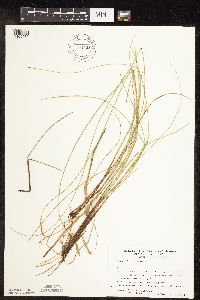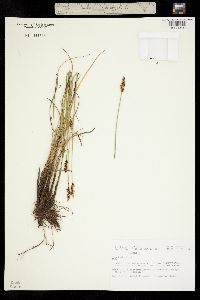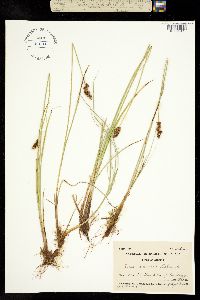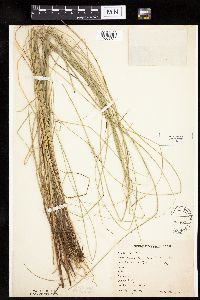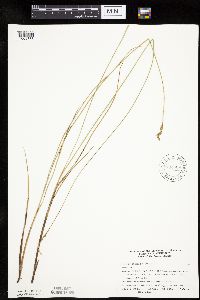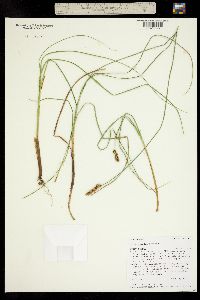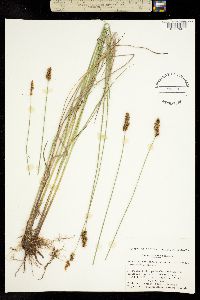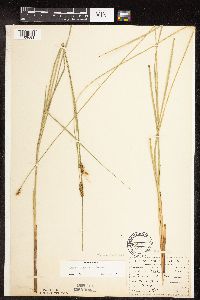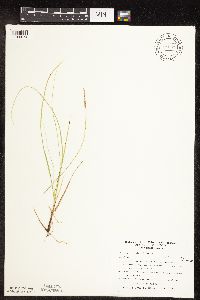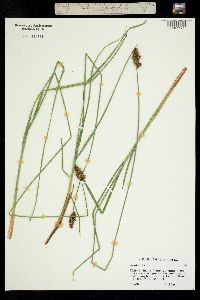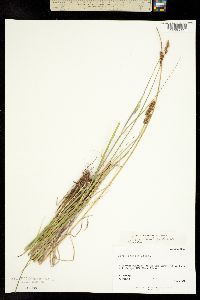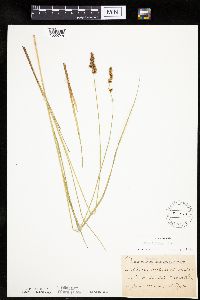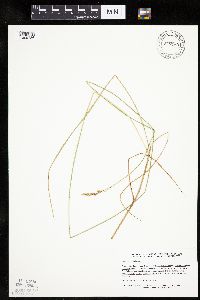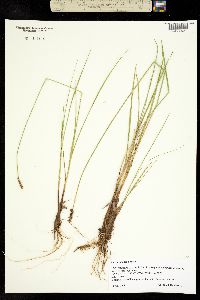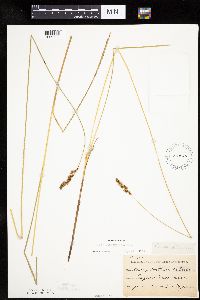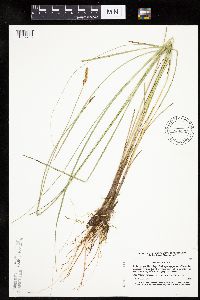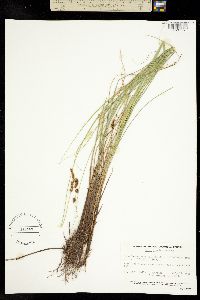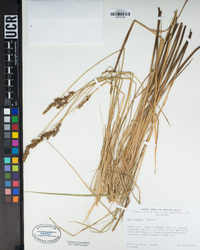Carex diandra
|
|
|
|
Family: Cyperaceae
Lesser Tussock Sedge
[Carex paniculata var. diandra (Schrank) Fiori, moreCarex teretiuscula var. ampla] |
Culms (1-)2-90 cm. Leaves: sheaths adaxially whitish, conspicuously red dotted, truncate or convex at mouth, prolonged 0.4-4(-6) mm beyond base of blade; ligules 8-57 mm; foliage leaf blades 14-30(-47) cm × 1-2.5 mm. Inflorescences bisexual, straight, little interrupted, ± compound (short branch at least on most proximal node or, occasionally, unbranched) , 2-5(-6) × 0.6-1.4(-1.7) cm, proximal 0-3 branches slightly overlapping 1 above; basal branch (when present) with 2-12 spikes; proximal internode 3-7(-10) mm. Pistillate scales straw colored or brownish, 1.5-2.7 × 0.9-1.6 mm, as wide as perigynia at base, narrower distally. Perigynia ± spreading, olive to dark chestnut brown, stongly 4-6-veined and finely 2-4-veined abaxially, with narrow median strip extending full length (grooved aspect emphasized by pair of bordering veins), often membranous flap toward apex, narrowly deltoid-ovoid, unequally biconvex, (2-)2.3-2.5(-2.9) × 1-1.4 mm, shiny; beak 0.9-1.1 mm. Achenes broadly compressed-ovoid, 1.4-1.7 × 0.7-1 mm. 2n = 48, 50, 54, 60. Fruiting late May-mid Aug (Sep in Calif.). Swampy, marshy, or boggy areas, especially wet meadows, fens, muskegs, floating mats, and peaty or marly shores of lakes and ponds (often in shallow, sometimes brackish water), less often swales, springy thickets, ditches, and wet sandy beaches of nonalkaline lakes; 0-2800 m; St. Pierre and Miquelon; Alta., B.C., Man., N.B., Nfld. and Labr., N.W.T., N.S., Nunavut, Ont., P.E.I., Que., Sask., Yukon; Alaska, Calif., Colo., Conn., Ill., Ind., Iowa, Maine, Md., Mass., Mich., Minn., Mont., Nebr., N.H., N.J., N.Y., N.Dak., Ohio, Oreg., Pa., R.I., Utah, Vt., Wash., Wis., Wyo.; Eurasia (including Iceland); Atlantic Islands (Canary Islands); Pacific Islands (New Zealand). Although common northward (but not at the highest latitudes except in District of Mackenzie and Yukon), this circumboreal sedge is occasional to rare throughout much of its United States range. Carex diandra was reported from Tennessee by J. K. Underwood (1945) and in lists of Tennessee plants on the basis of an old specimen that has been destroyed. H. A. Gleason and A. Cronquist´s (1963, 1991) report for Missouri, quoted in later floras and catalogues, is believed to be erroneous. See comments under C. prairea.
Stems densely clustered, 3-10 dm, aphyllopodic, rather slender above; lvs ±elongate, ±flat, mostly 1-2.5 mm wide; sheaths ventrally pale and red-dotted, prolonged 2-3 mm beyond the base of the blade; spikes androgynous, ±numerous, small, sessile, aggregated into a compact but branched infl 2-3.5(-5) cm long and seldom over 1 cm thick; bracts small, setaceous or almost like the pistillate scales; stamens 3 (in spite of the name); scales largely hyaline-scarious and stramineous or brownish, with firmer, sometimes shortly excurrent midrib; perigynia ovate or lance-ovate, 2.4-3 mm, half as wide, usually dark brown, shining, ±spreading, very firm and thick-walled, the nerveless ventral surface slightly convex and often exposed in the spike, the dorsal surface strongly convex and with a median thin, often depressed and pale strip (an extension of the dorsal suture) bordered by a pair of veins and reaching to the base; beak ±abruptly differentiated from the body of the perigynium, coarse, serrulate-margined, often pale or greenish; achene lenticular; 2n=60. Swamps, wet meadows, and Sphagnum-bogs; circumboreal, s. to N.J., Pa., Ind., Mo., Colo., and Calif. Gleason, Henry A. & Cronquist, Arthur J. 1991. Manual of vascular plants of northeastern United States and adjacent Canada. lxxv + 910 pp. ©The New York Botanical Garden. All rights reserved. Used by permission. From Flora of Indiana (1940) by Charles C. Deam Frequent in the lake area on marly and sandy borders of lakes and in swales, marshes, or bogs. The specimen upon which Coulter's report from Daviess County was based should probably be referred to C. prairea. The specimen could not be located in the Indiana herbaria. ...... Indiana Coefficient of Conservatism: C = 10 Wetland Indicator Status: OBL |











